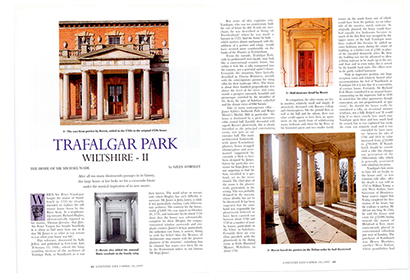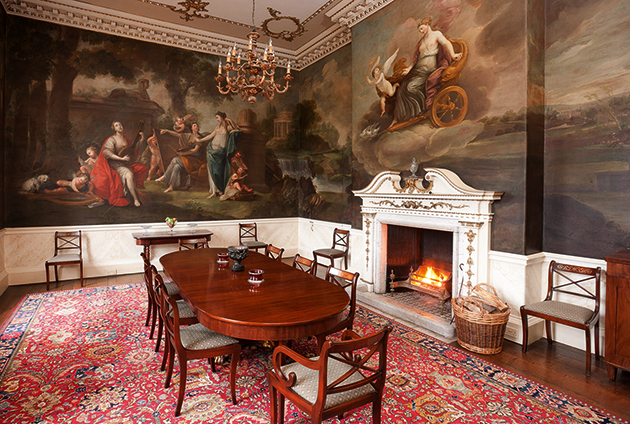Trafalgar Park: The ultimate restoration
Trafalgar Park was gifted in 1814 to the Nelson family after that famous battle, and now represents an opprtunity for the ultimate restoration


Writing in Country Life of historic, Grade I-listed Trafalgar Park at Downton, near Salisbury, Wiltshire, in the late 1990s (April 3 and 10, 1997), the magazine’s former architectural editor, Giles Worsley, memorably referred to the house as ‘the Flying Dutchman of the property world, endlessly seeking an owner and being sold on while the fabric slowly decayed’. Seen from a property man’s perspective, however, the house built in 1733 for City grandee Sir Peter Vandeput and originally known as Standlynch Park, was ‘an estate agent’s dream, a house that always seemed to come back on the market’.

One way or another, the rot started when Sir Peter died in 1748 and, four years later, the house and its estate were sold by his heir to a rich West Indian planter, William Young, later governor of Dominica. He, too, developed itchy feet and, in 1766, sold the house and estate for £22,000 to an even richer West Indian, Henry Dawkins, whose grandfather had been one of the first settlers in Jamaica.
On Dawkins’s death in 1814, the house and estate, by then extended and gentrified, were again put up for sale, and bought by the Crown on behalf of the Nelson family as reward for the Admiral’s famous victory at Trafalgar in 1805. Horatio Nelson had, of course, been killed in the battle and Standlynch Park (known thereafter as Trafalgar House) and its estate, valued at £90,000—along with a pension of £5,000 a year—were settled instead on his brother William, an unassuming clergyman who was created 1st Earl Nelson.
Enriched by marriage and inheritance, his successors expanded their land holdings to 7,196 acres by 1884, but failed to weather the agricultural downturn of the late 19th and early 20th centuries. After the Second World War, punitive death duties and the abolition of the Nelson pension by the Labour government in 1947 forced the sale of the mansion and its remaining 3,415 acres to the Duke of Leeds for an estimated £58,000 in 1948. The Duke’s son-in-law, later Viscount Chandos, was installed as sitting tenant in the house, which he eventually bought with only 10 acres of land when the rest of the estate was sold to the neighbouring Longford Castle estate in 1953.
The Chandoses lived at Trafalgar House in some style until 1971, when Lord Chandos sold the house to banker Jeremy Pinckney for an estimated £75,000. His stay was a short one and, in 1978, the house was back on the market. The new owner, Tertius Murray Thriepland, ran a successful business from the stables and south wing, but without a reasonable amount of land, a house of this size didn’t really work for him, so, in 1992 he sold it, moved his enterprise to a business park in Salisbury and bought an estate on the other side of the valley.
The new owner was Gunnar Bengtsson, a Swedish hotelier with a passion for Nelsoniana, who owned three Nelson-themed hotels in Stockholm and planned to create another at Trafalgar House. Alas, he was stopped in his tracks by the recession of the 1990s, and, despite frequent advertisements in Country Life, the house remained unsold and unlived in. Conservation bodies began to fret as the buildings—especially the north wing, which had lain empty since the Second World War—continued to deteriorate.
Things were not looking good until, one day in 1995, its present owner, Michael Wade, having seen Trafalgar House in the pages of Country Life, went to look at it with no real intention of buying and was instantly smitten. The rest is an interesting piece of property history.
Exquisite houses, the beauty of Nature, and how to get the most from your life, straight to your inbox.

As a successful City underwriter of many years’ standing, the need to equate risk with reward was a concept familiar to Mr Wade, whose great passions in life were music—notably opera and chamber music—and the Arts. He saw Trafalgar House as ‘a piece of art, an architectural gem’ and rightly so. For all its problems, the great merit of the house was its architectural integrity, the original building having remained virtually unchanged —apart from the north and south wings by John Wood of Bath and the imposing east-front portico by Nicholas Revett, all added by Dawkins in the late 1770s.
Mr Wade’s vision for Trafalgar Park, as he renamed it, was to turn the house into an important centre for music, with the specific aim of encouraging young artists. The project envisaged converting the south wing into a family home, using the main block of the house to entertain corporate sponsors and transforming the derelict north wing into an auditorium based on elements of Revett’s original design.
Despite the fact that the proposed scheme involved significant alterations to a Grade I-listed house, Worsley and other architectural experts were generally supportive, given that the alterations involved were ‘markedly less damaging than earlier proposals for which planning permission was given’ and that ‘the creation of the auditorium could add a new layer to the architectural history of the building, much as Henry Dawkins added a new layer to Sir Peter Vandeput’s house, while respecting the integrity of the original’.

Sadly, it was a view that failed to resonate with the conservationists, who resolutely refused to allow the removal of internal walls in the north wing to accommodate the auditorium central to Mr Wade’s concept. Nevertheless, he has soldiered on for the past 21 years, restoring Revett’s grand portico and his magnificent reception rooms in the main, three-storey house—notably the former music room painted by Giovanni Battista Cipriani, the Baroque hall and the Saloon. These rooms have provided a spectacular setting for operatic, orchestral and theatrical events, a venue for weddings and conferences and a location for TV and film dramas.
True to his original plan, the south wing has been reconfigured as a practical, two-storey family unit with a large new kitchen and a swimming pool overlooked by an 18th-century balustrade inspired by a design from Croome Court, Worcestershire. In terms of added value, perhaps Mr Wade’s most inspired achievement was the acquisition at the outset of additional parkland from the Longford Castle estate, which increased the acreage around the house to some 33 acres in all and allowed him to create a dramatic new east entrance and driveway, with planning permission to construct a pair of gate lodges. The north wing was simply ‘made good’ structurally and mothballed as an impressive shell, while awaiting the planning consent that never came.
Had it done so, Trafalgar Park might never again have figured in the advertisement pages of Country Life, but it didn’t and Mr Wade’s dream now passes to Savills (020–7016 3780) as they oversee the re-launch of property’s proud Flying Dutchman in today’s magazine at a guide price of £12 million.
** Search more country houses for sale
** Read more pieces about the best country houses on the market

